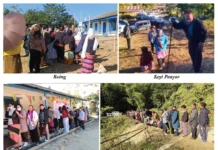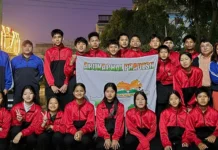Monday Musing
[ Amar Sangno ]
Acrimonious, inflammatory, inciting, hateful, prejudicial – all the adjectives that describe hatred don’t seem to run out of circulation on social media these days.
The vilification campaign against Chief Minister Pema Khandu on social media over the administrative autonomy demanded by the people of West Kameng and Tawang districts and the people of the Patkai region is a spontaneous reaction to the proposal of selective autonomy for the two regions.
The argument of other indigenous tribes of the state is that the move itself is divisive and detrimental to the concept of a pan-Arunachal identity. Another popular argument is that all of Arunachal should fall under the 6th schedule of the constitution if we are to seek constitutional protection of our tribal rights.
The people of other tribes are irked by the ground on which the Mon and the Patkai regions are being demanded. If socioeconomic backwardness is the criterion for demanding autonomy, almost the entire state should fall under the 6th schedule.
The outrageous criticism and condemnation from all quarters against the chief minister are perhaps because Khandu belongs to the Mon region and the demand for MAR has been renewed under his chief ministership.
The issue of autonomy had first been brought up in the assembly by the then home minister James L Wanglat, under the United Democratic Front government, in 2003-04. Three chief ministers – Gegong Apang, late Dorjee Khandu and Nabam Tuki – supported the move during their tenures, probably by way of political appeasement of the resentful regions.
There was no opposing voice, other than that of the All Arunachal Pradesh Students’ Union’s. Nonetheless, critics have turned a blind eye to the leaders who pushed the resolution in the legislative assembly in 2004 and 2013.
The demands for autonomy are the result of the shortsighted political visions of our leaders who were involved, contradicting the pan-Arunachal identity. They ignored the need for constitutional safety of all the indigenous tribes of Arunachal, which is testimony that our leaders, unlike the leaders of other tribal states like Nagaland and Mizoram, never seriously contemplated the need for protection of tribal rights since the attainment of statehood in 1987.
The renewal of the demand for MAR has indeed woken up our state’s people from slumber and is forcing us to revisit the constitutional provisions for our state.
We are living in an illusory world, pompously blinded by the thought that, being a tribal state, we are constitutionally protected. The truth is that we are not constitutionally protected like the Nagas under Article 371 (A) and the Mizos under Article 371 (G), and other tribal areas in Assam, Tripura and Meghalaya under the 6th schedule.
Imperial era regulations, such as the Bengal Eastern Frontier Regulation, 1873, the Chin Hills Regulation, 1896, and the Balipara/Tirap/Sadiya Frontier Tract Jhum Land Regulation, 1947, are providing Arunachal temporary protection. The state is neither under the 5th schedule nor under the 6th schedule of the Indian constitution.
Article 371 (H) confers upon the governor a special provision; in fact, it is a repressive tool that the governor is empowered to use in the event of any law and order crisis in the state. It was grossly misused by the then governor Jyoti Prasad Rajkhowa in 2016, invoking President’s Rule in the state to topple the then chief minister Nabam Tuki’s government.
It clearly states that “the governor of Arunachal Pradesh shall have special responsibility with respect to law and order in the state of Arunachal Pradesh and discharge of his function in relation thereto, the governor shall, after consulting the council of minister, exercise his individual judgment as to the action to be taken.”
Instead of engaging in vitriolic debates on social media, especially against the tribes and the regions that are seeking autonomy, it is time we sought constitutional protection of our tribal rights, our way of living, our customary laws, land ownership and possession rights, and more so our tribal traditions and cultures. The interests of Arunachal lie in having them protected by the constitution.
The onus is on every responsible Arunachalee to push for protection of our territorial and cultural rights. Divided we fall, united we achieve.



